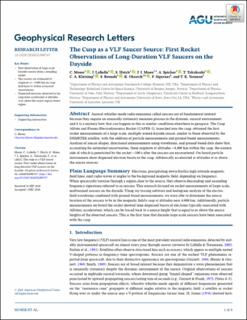| dc.contributor.author | Moser, Chrystal | |
| dc.contributor.author | LaBelle, James William | |
| dc.contributor.author | Hatch, Spencer Mark | |
| dc.contributor.author | Moen, Jøran Idar | |
| dc.contributor.author | Spicher, Andres | |
| dc.contributor.author | Takahashi, Toru | |
| dc.contributor.author | Kletzing, Craig A. | |
| dc.contributor.author | Bounds, Scott Randolph | |
| dc.contributor.author | Oksavik, Kjellmar | |
| dc.contributor.author | Sigernes, Fred | |
| dc.contributor.author | Yeoman, Timothy K. | |
| dc.date.accessioned | 2021-06-02T10:32:24Z | |
| dc.date.available | 2021-06-02T10:32:24Z | |
| dc.date.created | 2020-12-10T07:52:52Z | |
| dc.date.issued | 2021 | |
| dc.identifier.issn | 0094-8276 | |
| dc.identifier.uri | https://hdl.handle.net/11250/2757356 | |
| dc.description.abstract | Auroral whistler‐mode radio emissions called saucers are of fundamental interest because they require an unusually stationary emission process in the dynamic auroral environment, and it is a mystery how that can happen in this or similar conditions elsewhere in geospace. The Cusp Alfvén and Plasma Electrodynamics Rocket (CAPER‐2), launched into the cusp, obtained the first rocket measurements of a large‐scale, multiple‐armed dayside saucer, similar to those observed by the DEMETER satellite, with the addition of particle measurements and ground‐based measurements. Analysis of saucer shapes, directional measurements using waveforms, and ground‐based data show that, accounting for estimated uncertainties, these originate at altitudes ∼4,000 km within the cusp, the eastern side of which is penetrated by the rocket ∼100 s after the saucers are encountered. On‐board particle instruments show dispersed electron bursts in the cusp, Alfvénically accelerated at altitudes at or above the saucer sources. | en_US |
| dc.language.iso | eng | en_US |
| dc.publisher | AGU | en_US |
| dc.relation.uri | https://agupubs.onlinelibrary.wiley.com/doi/epdf/10.1029/2020GL090747 | |
| dc.title | The Cusp as a VLF Saucer Source: First Rocket Observations of Long‐Duration VLF Saucers on the Dayside | en_US |
| dc.type | Journal article | en_US |
| dc.type | Peer reviewed | en_US |
| dc.description.version | publishedVersion | en_US |
| dc.rights.holder | Copyright 2020. American Geophysical Union. All Rights Reserved. | en_US |
| dc.source.articlenumber | e2020GL090747 | en_US |
| cristin.ispublished | true | |
| cristin.fulltext | original | |
| cristin.qualitycode | 2 | |
| dc.identifier.doi | 10.1029/2020GL090747 | |
| dc.identifier.cristin | 1858134 | |
| dc.source.journal | Geophysical Research Letters | en_US |
| dc.relation.project | Norges forskningsråd: 223252 | en_US |
| dc.identifier.citation | Geophysical Research Letters. 2021, 48(2), e2020GL090747 | en_US |
| dc.source.volume | 48 | en_US |
| dc.source.issue | 2 | en_US |
